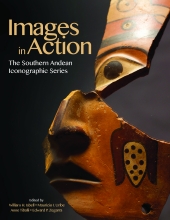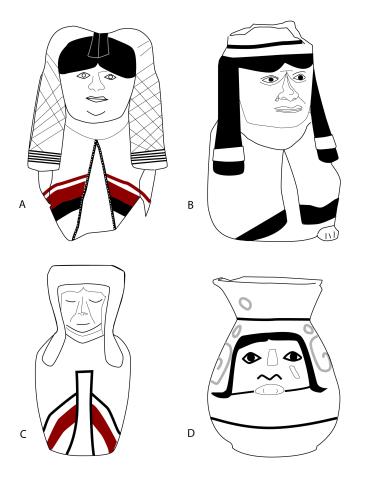20.24
Tiwanaku effigy jars show females in seated or kneeling poses in which hands and feet are often only implied by the modeled form. (a) This is one of several jar fragments from Pariti found as part of a buried cache of ceramics, many of which represented females clothed in striped mantles and wearing a lobed headdress or elaborate hairdo. A small raised bump of clay on the right cheek, near the nose, may represent a mole, suggesting that the vessel is a portrait of an actual person, not merely an idealized image. Drawn from photo by A. Korpisaari (Korpisaari and Parssinen 2005:Photo 4); (b) this vessel from Cochabamba depicts a sitting or kneeling female with one knee raised. Like the Pariti figure, her mantle has a dark stripe at the hem and her hair is held in place by two large strips at the bottom of the braids. Drawn from black and white photo (Eisleb and Strelow 1980:Plate 258); (c) another vessel from the Cochabamba region depicting a female figure in a striped mantle and perhaps a headdress. Drawn from black and white photo (Eisleb and Strelow 1980:Plate 259); (d) a vasija vessel form with a painted and modeled female face as the main element of decoration. Like other females, her hair is parted to either side and she may have "tear marks" on her cheeks. Like many effigies, the nose is modeled, but in a uniquely Tiwanaku twist, the chin is also modeled to give it prominence.
Item record
Image contents
Reuse
Isbell, William H.; Uribe, Mauricio I.; Tiballi, Anne; Edward P. Zegarra, 2018, "Visual database", https://doi.org/10.25346/S6/1B33FN.

